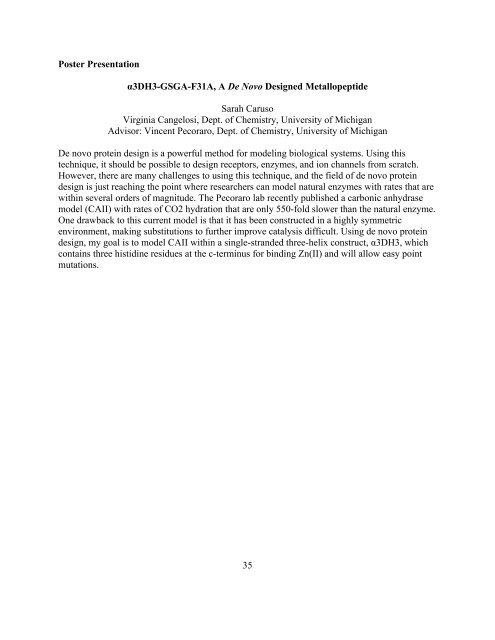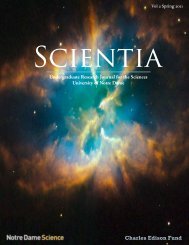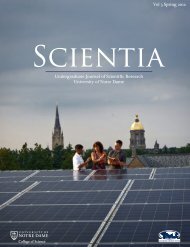- Page 1: SUMMER UNDERGRADUATERESEARCH SYMPOS
- Page 4 and 5: Oral Presentations ScheduleBiology,
- Page 6 and 7: Physics Jordan Room 322Session III1
- Page 8 and 9: Heather Fick, Jennifer Parra, Kirin
- Page 10 and 11: Nathaniel Wirgau - Synthesis and Ch
- Page 12 and 13: Cameron Moore - Optimizing Paper Te
- Page 14 and 15: Poster PresentationEspN and FL-EC7
- Page 16 and 17: Poster PresentationThermal Rectifie
- Page 18 and 19: Poster PresentationSynthesis of a G
- Page 20 and 21: Poster PresentationLight It Up: Hig
- Page 22 and 23: Poster PresentationExternal modulat
- Page 24 and 25: Poster PresentationCreating a Devic
- Page 26 and 27: Poster PresentationDevelopment of a
- Page 28 and 29: Poster PresentationElectrostatic Do
- Page 30 and 31: Poster PresentationBiological Chara
- Page 32 and 33: Oral PresentationDamage of DNA in D
- Page 36 and 37: Poster PresentationInteger Solution
- Page 38 and 39: Poster PresentationTcpP Diffusion R
- Page 40 and 41: Poster PresentationThe New Digital
- Page 42 and 43: Poster PresentationSynthesis of Nic
- Page 44 and 45: Poster PresentationModeling the For
- Page 46 and 47: Poster PresentationInverse Islands:
- Page 48 and 49: Poster PresentationExamining the Co
- Page 50 and 51: Poster PresentationPlasmon-Enhanced
- Page 52 and 53: Poster PresentationCharacterization
- Page 54 and 55: Poster PresentationSynthesis of α-
- Page 56 and 57: Poster PresentationNon-Invasive Opt
- Page 58 and 59: Poster PresentationAn Investigation
- Page 60 and 61: Poster PresentationVisualizing Mism
- Page 62 and 63: Poster PresentationMaking Gasoline
- Page 64 and 65: Poster PresentationPrivacyRangerDan
- Page 66 and 67: Oral PresentationUnderstanding Stro
- Page 68 and 69: Poster PresentationEnzymatic Synthe
- Page 70 and 71: Poster PresentationVisualizing Imit
- Page 72 and 73: Poster PresentationBiomechanical En
- Page 74 and 75: Poster PresentationPolymer-Template
- Page 76 and 77: Poster PresentationThe Role of GRP7
- Page 78 and 79: Poster PresentationFeasibility of g
- Page 80 and 81: Poster PresentationA Simple Method
- Page 82 and 83: Oral PresentationSyntheses and SAR
- Page 84 and 85:
Poster PresentationMicrocontact Pri
- Page 86 and 87:
Poster PresentationAssay Developmen
- Page 88 and 89:
Poster PresentationInvestigating In
- Page 90 and 91:
Poster PresentationThermosensitive
- Page 92 and 93:
Oral PresentationThe World’s Firs
- Page 94 and 95:
Poster PresentationManipulation of
- Page 96 and 97:
Oral and Poster PresentationMathema
- Page 98 and 99:
Poster PresentationCharacterization
- Page 100 and 101:
Oral PresentationExploring the Grow
- Page 102 and 103:
Poster PresentationPossible Student
- Page 104 and 105:
Poster PresentationEvaluating the E
- Page 106 and 107:
Poster PresentationExamining Interp
- Page 108 and 109:
Poster PresentationRaman Spectrosco
- Page 110 and 111:
Poster PresentationAn Enantioselect
- Page 112 and 113:
Poster PresentationRoles and Intera
- Page 114 and 115:
Poster PresentationPerformance Eval
- Page 116 and 117:
Poster PresentationMechanisms Gover
- Page 118 and 119:
Poster PresentationCarbon Dioxide C
- Page 120 and 121:
Oral PresentationA Parametric Model
- Page 122 and 123:
Poster PresentationAnalysis of hole
- Page 124 and 125:
Poster PresentationSynthesis of New
- Page 126 and 127:
Poster PresentationEmploying the En
- Page 128 and 129:
Poster PresentationIdentifying the
- Page 130 and 131:
Poster PresentationThe Geppetto Pro
- Page 132 and 133:
Poster PresentationGeneration and c
- Page 134 and 135:
Oral PresentationDouble Folding Ana
- Page 136 and 137:
Poster PresentationCrystalline InSb
- Page 138 and 139:
Poster PresentationPopulation genet
- Page 140 and 141:
Poster PresentationFunctional chara
- Page 142 and 143:
Poster PresentationDevelopment of s
- Page 144 and 145:
Oral PresentationBeam Monitor Proto
- Page 146 and 147:
Poster PresentationRole of cyclins
- Page 148 and 149:
Poster PresentationHey! Can Someone
- Page 150 and 151:
Oral PresentationDelineation of the
- Page 152 and 153:
Poster PresentationData Git: Proven
- Page 154 and 155:
Poster PresentationDetermining the
- Page 156 and 157:
Poster PresentationEffects of pH on
- Page 158 and 159:
Oral PresentationExploring the Coll
- Page 160 and 161:
Poster PresentationMD Simulations R
- Page 162 and 163:
Poster PresentationAnalysis of luna
- Page 164 and 165:
Poster PresentationStasis of Saltwa
- Page 166 and 167:
Poster PresentationSynthetic proces
- Page 168 and 169:
Poster PresentationHurricane and St
- Page 170 and 171:
Poster PresentationReceptor Interac
- Page 172 and 173:
Poster PresentationSynthesis and Ch
- Page 174 and 175:
Oral PresentationSummary of CMS Min
- Page 176 and 177:
Oral PresentationConstructing and T
- Page 178 and 179:
INDEX TO ABSTRACTSAcevedo, Ephraim






